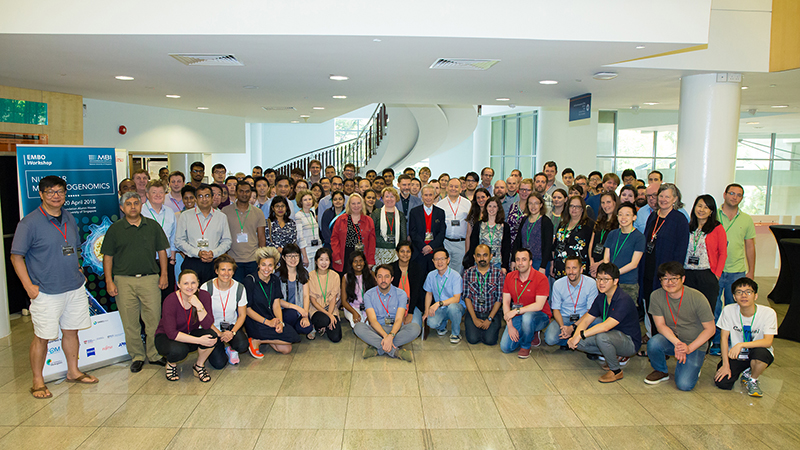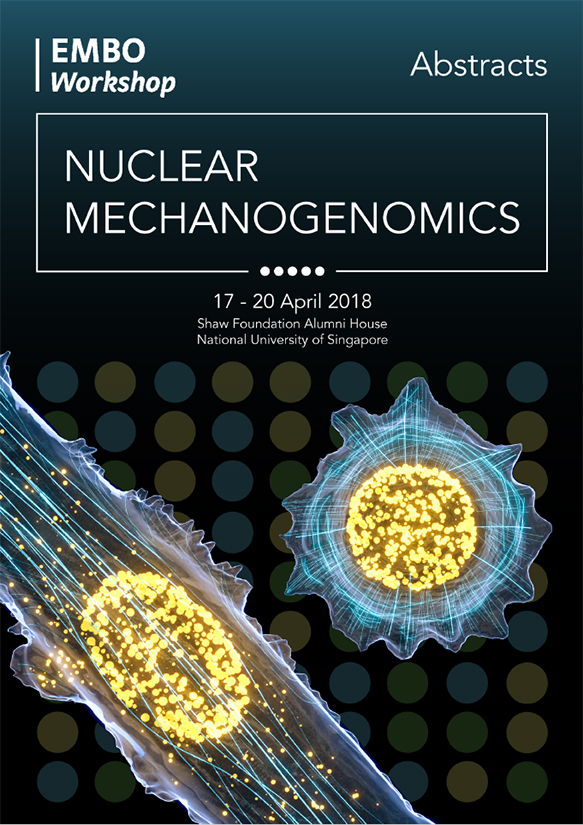EMBO Workshop on Nuclear Mechanogenomics: Post-event report
SRUTHI JAGANNATHAN | May 2018
The EMBO Workshop on Nuclear Mechanogenomics, co-organized by G.V. Shivashankar of the Mechanobiology Institute, Dennis Discher of the University of Pennsylvania, and Valerie Weaver of the University of California, was held on April 17-20 at the Shaw Foundation Alumni House, National University of Singapore. The primary objective of the workshop was to bring together pioneering academics, early career scientists and post-doctoral and graduate scholars to discuss the latest advancements and challenges facing the rapidly emerging field of nuclear mechanogenomics.
Centered on the mechanistic principles driving nuclear structure and function, the 4-day workshop covered a broad range of ideas under four major themes: mechanics of 4D nucleome and genome integrity, nuclear mechanics and mechanotransduction, nuclear mechanics and genome integrity, and nuclear mechano-pathology. The program, which incorporated invited talks, selected short talks, posters and social events, generated much discussion, and lent deeper insights into the various aspects of nuclear mechanics research: from how forces are relayed to the nucleus to how the nucleus responds. Of particular interest was how the mechanical state of the nucleus is altered under stress, and how this impacts the organization of the genome inside, with serious implications in health and disease. Understanding this kind of a dynamic nuclear response is vital, since it ultimately controls gene expression programs, enabling the cell to modulate its behavior in response to mechanical signals from its surroundings.
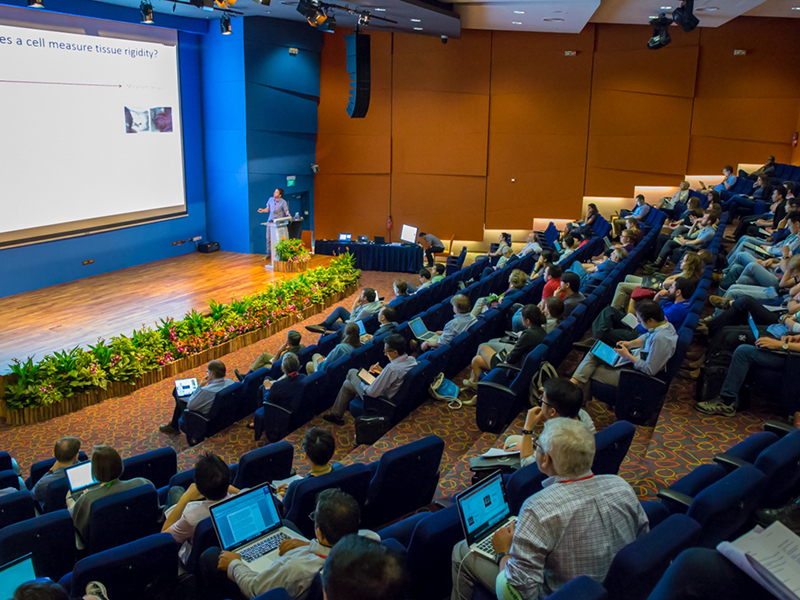
Pere-Rocha Cusachs from the Institute for Bioengineering of Catalonia, Spain speaking on Day 2 of the workshop
One of the key points addressed was the role of LINC complexes in relaying mechanical signals from the extracellular environment to the nucleus. LINC complexes are structural elements that physically connect the cytoplasm and the nucleus, disruptions to which result in impaired force transmission, and are associated with skeletal muscle diseases such as muscular dystrophies and cardiomyopathy. As highlighted through talks by several speakers, including Megan C King from Yale School of Medicine, Colin Stewart from the Institute of Medical Biology, and Joe Swift of the University of Manchester, LINC complexes are proving particularly relevant in nuclear mechanosignaling, especially for their role in the maintenance of skeletal muscle. The LINC complex is now serving as a novel therapeutic target for certain muscle pathologies.

Colin Stewart, Institute of Medical Biology, Singapore
Talks also covered mechanotransduction, which is the direct transmission of mechanical signals through the activation of biochemical signaling pathways, and which can lead to the transport of genome regulators into the nucleus. Several speakers, including Stefano Picolo of the University of Padova, Italy, Pere-Roca Cusachs of IBEC, Spain, and Julia Sero of Imperial College London, presented on the latest in this subcellular process, focusing on the mechanisms driving the nuclear entry of genome regulators like YAP and MRTF. Of particular interest was the notion that forces act on the nuclear envelope to stretch nuclear pores, allowing genome regulators such as YAP to pass through easily. Aiding this process is the fact that forces partially unfold these molecules, which further facilitates their transit through the pores.
Much discussion focused on how the molecular structures found inside the nucleus influence its physical properties. For instance, presentations by Jan Lammerding of Cornell University, Ohad Medalia of the University of Zurich, and Quasar S Padiath of the University of Pittsburg, among others, added much to the current knowledge on the role of the nuclear lamina in defining the mechanical properties of the nucleus. This filamentous network of lamin proteins influences nuclear stiffness, and the extent to which nuclear size and shape can be altered under compressive forces. Tanmay Lele of the University of Florida provided updates to the well-established phenomena that the shape of the nucleus changes in response to changes in cell shape. Of particular note was the idea that nuclear deformations are irreversible and are shaped by the direction in which the cell boundary moves. This was in contrast to the accepted notion that deformed nuclei regain their original shapes when cytoplasmic forces are removed.
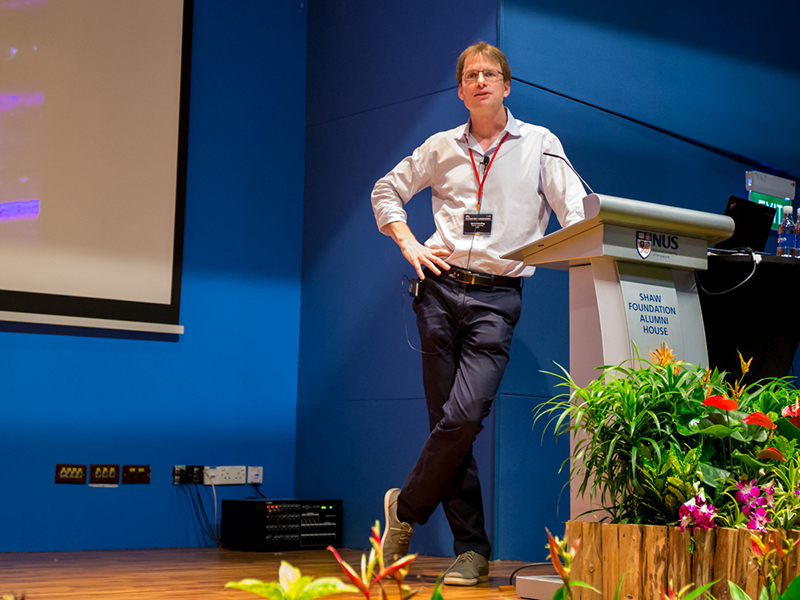
Jan Lammerding, Cornell University, USA
Scientific presentations followed 4 major themes: Mechanics of 4D nucleome and genome regulation, nuclear mechanics and mechano-transduction, nuclear mechanics and genome integrity and mechano-pathology.
Importantly, defective lamina affects genome integrity, increases the occurrence of nuclear envelope defects, and leads to serious genetic disorders like progeria and muscular dystrophies as well as cancers. The mechanical aspects of these pathological phenomena, which were discussed by Dennis Discher of University of Pennsylvania, John Marko of Northwestern University, Illinois, and Oliver Dreesen from the Institute of Medical Biology, Singapore, remains an extensively researched topic, with exciting progress expected in the near future. Discussing on yet another important role for nuclear mechanics in cell fate specification, a talk by G.V. Shivashankar of the Mechanobiology Institute, described novel approaches to induce cell reprogramming, such as growing single cells through multiple cell cycles under mechanical confinement. In this work, spheroids of cells develop that acquire pluripotent properties.
Another area of study that is gaining significant attention is the three-dimensional arrangement of the genome inside the nucleus, and in particular, how it is impacted by external mechanical signals, and the inherent physical state of the nucleus. With advanced imaging tools, genome sequencing and computational methodologies now at their disposal, several speakers, including Cristoph Cremer, from IMB-Mainz, Germany and Caroline Uhler from MIT, USA, spoke of new methods by which unique patterns in the arrangement of the genome can be quantified under a given set of mechanical conditions. Using the methods discussed, researchers can now infer how these arrangements lead to differences in behavior between cell types, or between normal cells and disease cells. With such genome mapping approaches holding promise as potential diagnostic tools for diseases like cancer, researchers have begun actively exploring this area of science in recent years.
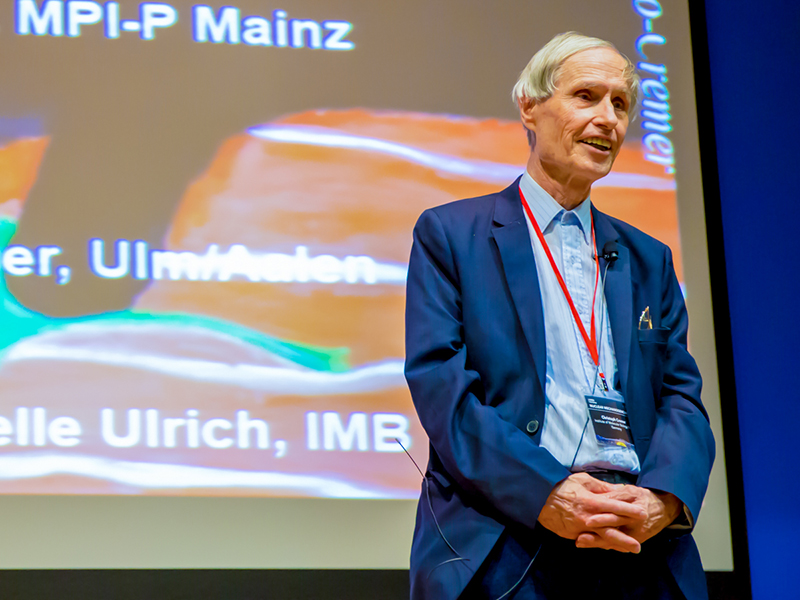
Christoph Cremer, IMB-Mainz, Germany
In addition, a major highlight of the workshop was the History of Science evening lecture series delivered by three distinguished academics: Daniela Rhodes of the Nanyang Technological University, Singapore took the audience through a 40-year journey leading up to the determination of chromatin structure; Mary Beckerle of the Huntsman Cancer Institute, University of Utah provided fresh perspectives on the interplay between cytoskeletal dynamics and nuclear function in response to mechanical stresses and its relevance in the progression of Ewing sarcoma; and Valerie Weaver of the University of California spoke in detail about the dynamic interplay existing between extrinsic and intrinsic forces in the regulation of cancer progression.

Mary Beckerle, Huntsman Cancer Institute at University of Utah, USA
In addition to stimulating discussions stemming from various presentations, the workshop also introduced the participants to many more new ideas and findings in the field through posters presented by postdoctoral and graduate scholars. Dedicated poster sessions on all four days, along with lightning (60 second) presentations to introduce the central theme of their posters, ensured adequate time and opportunity for the poster participants to present their research to the audience. Out of the 41 posters on display, three were awarded best poster prizes based on content and presentation. Of these awards, the EMBO Outstanding Poster award was presented to PhD candidate Aglaja Kopf from the Sixt Lab at IST Austria.
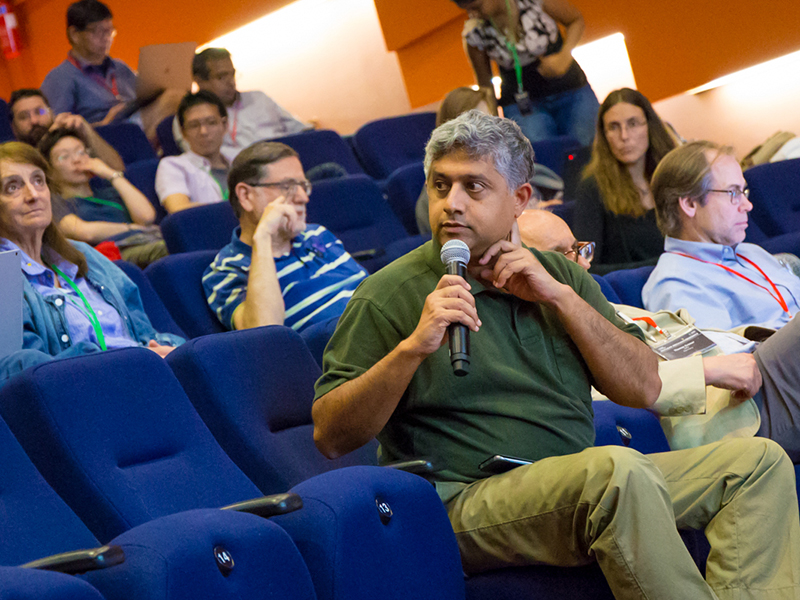
Workshop organizer G.V Shivashankar, from the Mechanobiology Institute, National University of Singapore and IFOM – the FIRC Institute of Molecular Oncology, Italy
Amidst the intense scientific discussions, the workshop also provided adequate time for social networking in the form of coffee breaks, lunch hours, and a special dinner banquet. Along with a good selection of food and beverages, the banquet provided great opportunities for the participants to network more and foster future research collaborations.
With 4 days of talks, posters and social events, the workshop successfully propelled meaningful discussions on the various aspects of nuclear mechanics research and advanced the current understanding of this emerging field.


